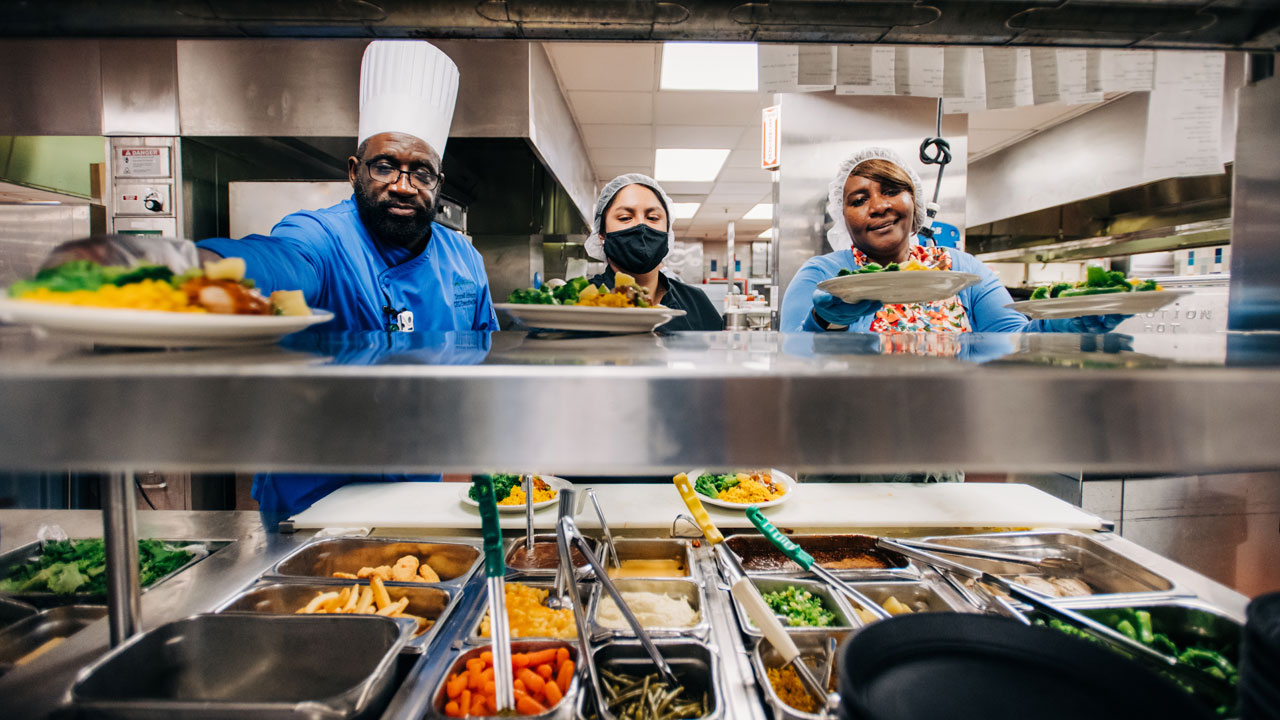People say UAB is like a city, and they’re not wrong. With a geographic area of more than 105 city blocks and more than 28,000 employees—not to mention many thousands of students, patients, and visitors on our campus and in our buildings around the clock—keeping things running smoothly requires careful organization and a herculean effort every day.
Many hands keep UAB running. Some roles receive much attention, while others may be mostly unsung. A range of specific skills, responsibilities, and shifts are often necessary, and finding and retaining employees who have particular training and an ability to work all hours of the day and night is no easy task.
While a single magazine story can’t begin to describe all that UAB people do to keep this institution running, we wanted to highlight how some of our employees get the job done, from food service in UAB Hospital to the Steam Plant operation to putting on exhibitions at Abroms-Engel Institute for the Visual Arts.
Here’s to the many committed Blazers who keep the wheels turning and the flame burning.
Meals that Help Heal Patients
Nutritious meals are a huge part of healing. When a patient in UAB Hospital orders a meal from the menu, the dedicated food services staff rely on a carefully designed system to deliver the best experience they can. Workers can prepare up to 3,600 meals in a day for patients and staff, every day, year-round—but not without challenges.
You can win people over with food, says Associate Vice President of Food, Nutrition and Guest Services John Brad Morrow, but you can also get them frustrated.
Meals are served room-service-style to patients, but few hotels, even with 1,000 rooms, would feed their customers breakfast, lunch, and dinner.
The magnitude of the task boggles the mind. For instance, a diabetic patient must eat before dialysis or risk blood sugar dropping. Someone who fasted prior to a procedure is now ready to eat. People with allergies need food prepared with extra care. Staff need something they can grab and go.
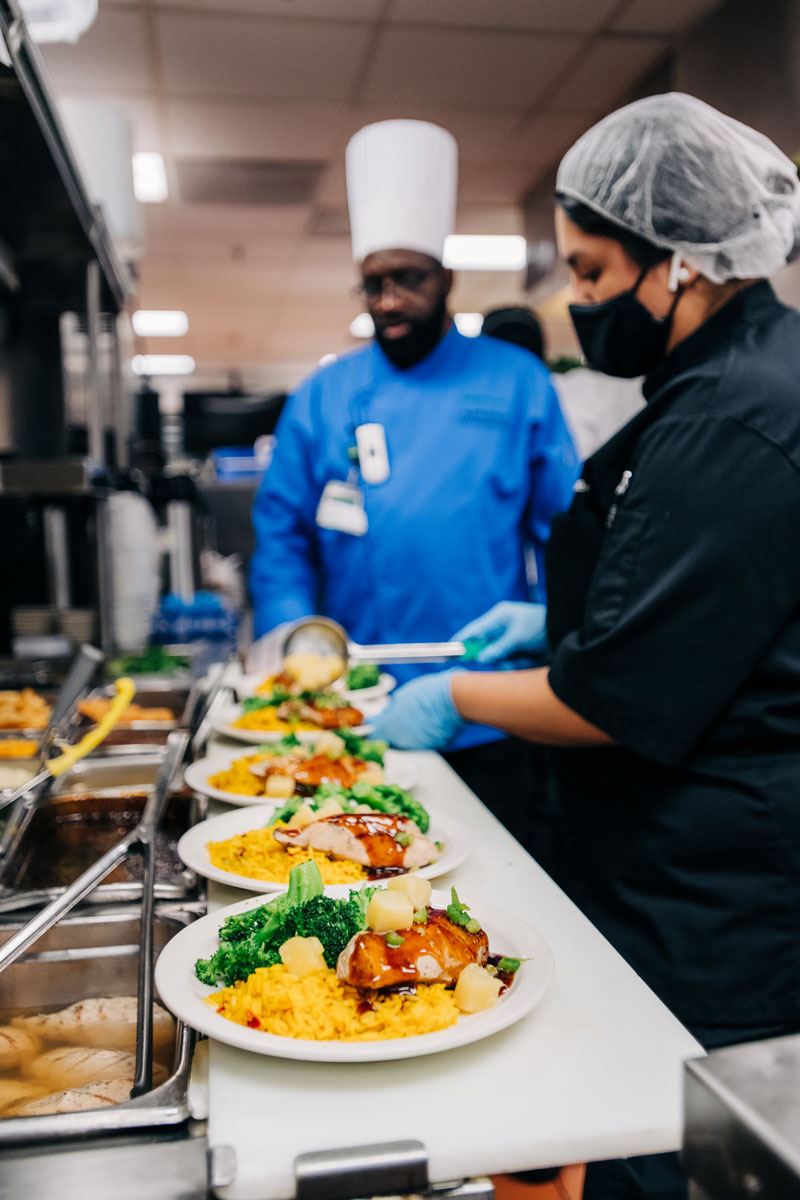 It takes a team: food is cooked and plated on the tray service lines, then delivered to patients by runners with trolleys. Food preparation, including slicing vegetables for salads, helps the kitchen run efficiently.
It takes a team: food is cooked and plated on the tray service lines, then delivered to patients by runners with trolleys. Food preparation, including slicing vegetables for salads, helps the kitchen run efficiently. Two kitchens provide patient service: one at the main UAB Hospital campus with 200 full time employees, and a second at UAB Highlands with 100 full time employees. A third kitchen feeds staff and visitors in the North Pavilion cafeteria. Highlands is a hybrid kitchen, cooking for the cafeteria and patients.
The main kitchen for patients is in the West Pavilion and serves 900 meals daily plus snacks. Ingredient prep plays a big part; just like at home, it saves money to perform tasks like slicing beef into tips rather than purchasing pre-sliced.
Overall, it is a massive operation, with an executive chef, a food service director, a management team, and supervisors over everything from the call center to sanitation to the tray service lines where the food is cooked, plated, and prepared for delivery. It’s a fast-paced job, and some of the roles are physically demanding. Like many businesses, food services can struggle with staff shortages. Capable and willing applicants can get training on the job.
Workers who take patient orders by phone are called diet clerks and are skilled in dietary and nutritional information as well as customer service. Meals are delivered on trollies manned by runners, and the clock is ticking to make sure each tray is fresh. If the timer runs down, that food is returned to the kitchen and the meals are remade. It’s a long distance from the West Pavilion to the Women and Infants Center or the North Pavilion, which does create some time challenges.
“With six million square feet in the hospital as a whole, and typically with as many beds as we have now, it is unprecedented that we have just one kitchen at the main campus,” Morrow said. Work with a consultant is underway to look at a strategic expansion plan to further improve food services.
Each patient’s diet plan is driven by a clinical nutrition team. Medical records provide a patient’s restrictions or allergies. The system, informed by a dietician, will dictate what a patient can and cannot have. If the order has too much sodium, too many calories or a problematic ingredient, it literally can’t be ordered. Pleasing people with their favorite flavor preferences, even for something as simple as a nutrient shake, is no small task.
“If a patient really wants a Caesar salad and it is not on the menu, we try to accommodate those when and where possible,” Morrow said. “Right now, we have a patient who has been here for some time and his favorite thing is cheese pizza. We have provided a pizza for him that we can feed him as often as he wants. It’s pretty awesome.”
Here in the South, it’s no surprise that the No. 1 food patients like to order is fried chicken. “People love what they love, and we want people to be happy with what they are getting,” Morrow said. It won’t be deep fried, but prepared in air fryers. The calories and sodium in food served to the general population is also carefully considered.
“Our goal is to come up with healthy alternatives, and we also want to provide a level of education,” he said. “Let’s get you home and then you can have the diet you want—even though you need to pay attention to your health care.”
Steam that Powers Campus
A simple process—which works much like the pressure cooker your grandmother may have used to cook green beans—provides heat and hot water across UAB’s campus.
That is the analogy Matt Winslett, director of Utilities Management, uses to describe the UAB Steam Plant. Heating water in a lidded pot increases pressure, along with the boiling point of the water inside, and cooks the beans a lot faster. This principle is known as Boyle’s Law.
However, this simple process uses a lot of complicated equipment.
UAB started operation of its own single district steam plant in spring 2013. It sits at the corner of Sixth Avenue South and 13th Street, across from Bartow Arena. Inside are four massive, water-tube boilers. Powered by natural gas, the boiler sends steam through nearly four miles of pipe to 45 buildings across campus and provides critical sterilization, humidification and dehumidification for operating rooms, research areas, and more.
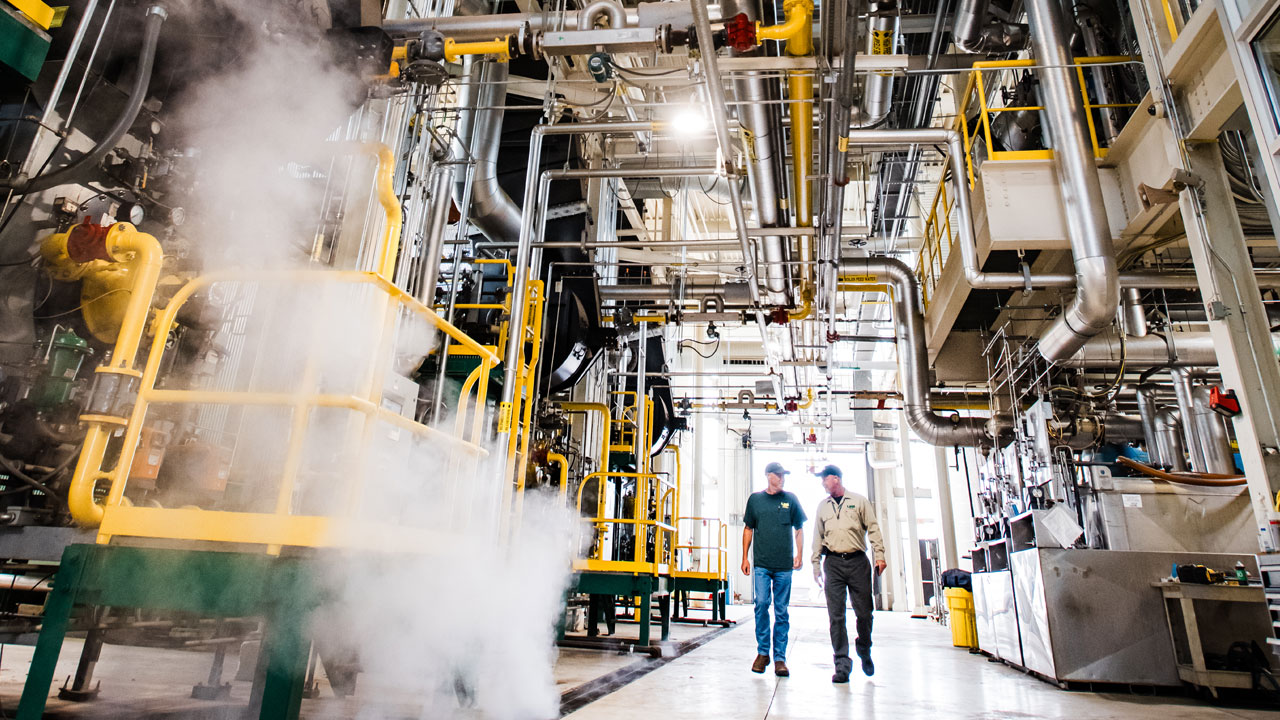 Each of the four boilers can convert 80,000 pounds of water into usable steam per hour. The water comes from three sources: drinking water, lake water, and on-site well water. The steam pipe runs underground at depths of 3 to 20 feet. Powered by natural gas, the boiler sends steam through nearly four miles of pipe to 45 buildings across campus. Workers in the pipe fitter department take care of the steam distribution lines.
Each of the four boilers can convert 80,000 pounds of water into usable steam per hour. The water comes from three sources: drinking water, lake water, and on-site well water. The steam pipe runs underground at depths of 3 to 20 feet. Powered by natural gas, the boiler sends steam through nearly four miles of pipe to 45 buildings across campus. Workers in the pipe fitter department take care of the steam distribution lines.
When Alabama Power closed its old Powell Avenue steam plant in 2008, UAB commissioned several studies on how to replace it. After spending two years analyzing 30 different options, the decision was made to build the university’s own plant. A condensate return system was one reason; the capture of hot condensate, left over from the steam and returned to the boiler for re-use, makes it much more efficient.
Two boilers are always online together; in case one fails, another can immediately back it up. Water comes in at a prescribed rate, based on how much steam is required, from three possible sources. The boiler heats the water to 435 degrees Fahrenheit steam and 140 pounds per square inch. The pressure alone sends it through the pipes out across campus, and by the time it reaches a building, it’s at about 350-375 degrees Fahrenheit.
The state-of-the-art system has backups to backups, with systems fed by two different Alabama Power Company substations. The sophisticated operations interface boasts some of the finest controls and monitoring equipment, and “looks like something you can control the space shuttle with,” Winslett said. The sealed control room is quiet and calm, with workers looking out through an observational window and always listening for the sound of alarms. In case of power failure, fly wheels that work off momentum will hold the 480-volt electrical load for up to three minutes until diesel generators can come online. The use of fuel oil as a backup can be cumbersome and expensive but was necessary for 48 hours during Christmas 2022.
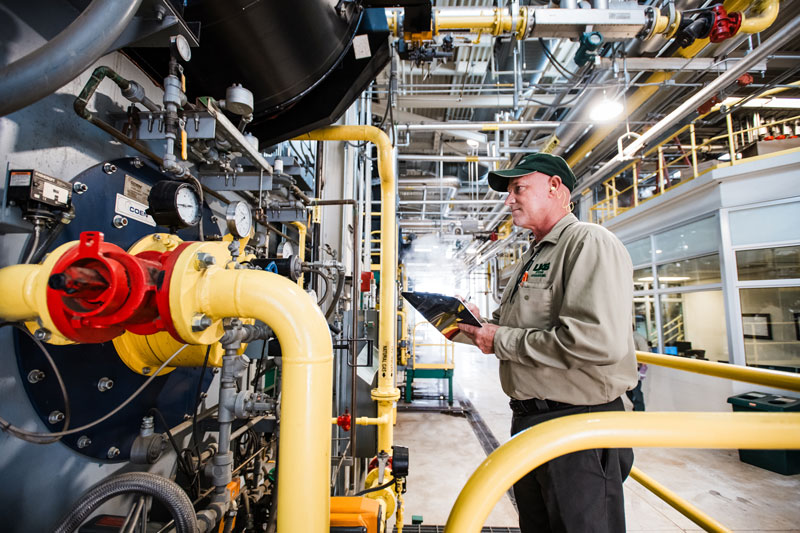 Boiler Operator Craig Stillwell takes live boiler parameter readings, which are manually done “hands-on” to keep everyone aware of the status of the boilers that are in operation. Water is heated to 435 degrees Fahrenheit steam and 140 pounds per square inch, which sends it through the pipes. By the time it reaches a building, it’s at about 350-375 degrees Fahrenheit. At least two operators from the team of 12 are always on the job to monitor the state-of-the-art system and listen for alarms. Half learned their trade in the military.
Boiler Operator Craig Stillwell takes live boiler parameter readings, which are manually done “hands-on” to keep everyone aware of the status of the boilers that are in operation. Water is heated to 435 degrees Fahrenheit steam and 140 pounds per square inch, which sends it through the pipes. By the time it reaches a building, it’s at about 350-375 degrees Fahrenheit. At least two operators from the team of 12 are always on the job to monitor the state-of-the-art system and listen for alarms. Half learned their trade in the military. “It is really high tech and really well thought-out to keep the place online, because it can never go down,” Winslett said. “It must run every day of the year; it is a 24/7, 365-day operation. It is safe and efficient, and meticulous records are kept of everything.”
A crew of 12 operators oversee the boilers, with two or three people there around the clock. At least half are former military, trained in the Navy or Air Force, says Instrument and Control Technician Mark Willard, while the rest earned their know-how at other facilities. It’s becoming more and more difficult to find workers skilled in the trade, Willard says. He and one other worker oversee instrument control work. A boiler mechanic maintains up to 140 boilers in individual buildings on campus and handles provision of domestic hot water for washing and other uses. Along with the team putting the steam out, a pipe fitter department takes care of the steam distribution lines.
The system has never gone down, thanks to the redundancies.
“We have had emergencies when it was going down, but we were able to save it,” Winslett said.
A boiler has been lost only a couple of times in 10 years, something he credits to Willard, “an amazing technical mind,” Winslett said. “He knows everything about this system.”
Art that Inspires the Community
What does it mean to be human? For the staff at UAB’s Abroms-Engel Institute for the Visual Arts Art, the answer to that question is art.
Contemporary art in a place like Birmingham, Alabama, is not necessarily an easy sell. No one expected AEIVA to be as successful as it has become. But since opening in January 2014, AEIVA has presented 83 exhibitions, had nearly 60,000 visitors, and become a premier destination in the state and region.
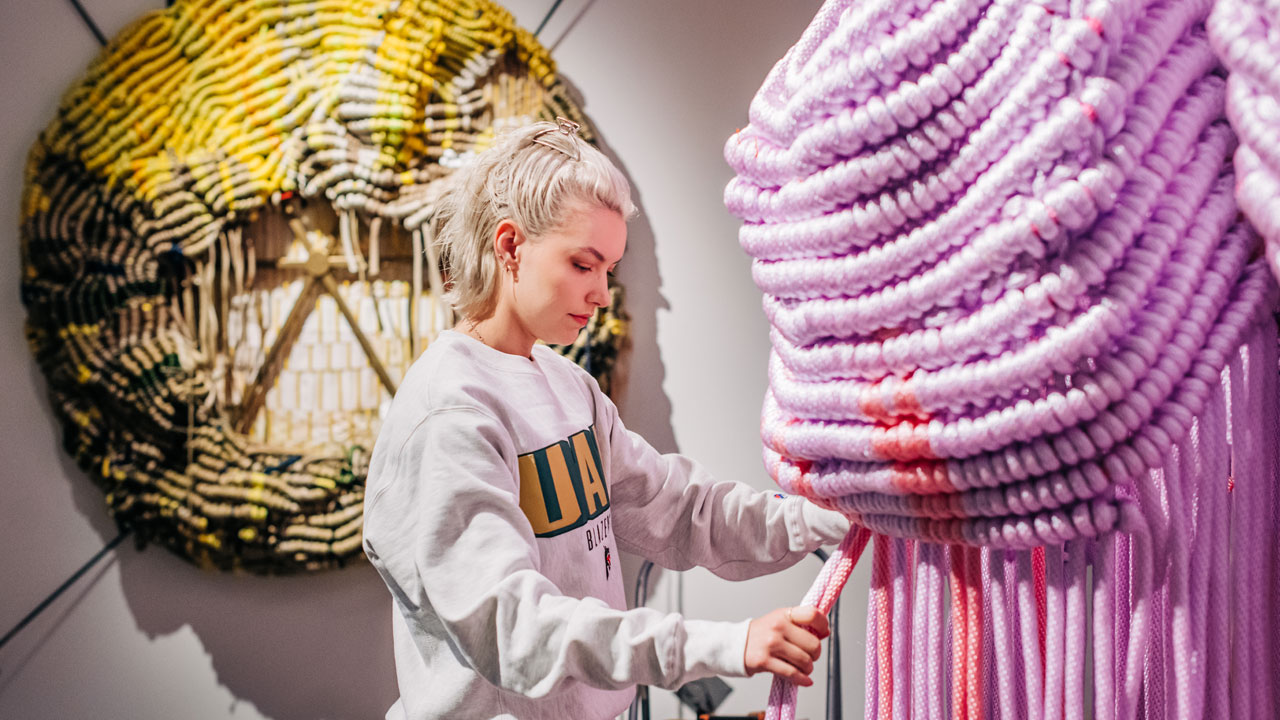 The work “Adoration Garden” by artist Jacqueline Surdell is the most physically demanding piece AEIVA has presented. The piece arrived from Chicago, and UAB Arts Alliance senior stage manager Seth Cain and staff volunteered to help install it. Made with nylon cord and steel spool for this exhibition, the piece is estimated to weigh more than 500 pounds.
The work “Adoration Garden” by artist Jacqueline Surdell is the most physically demanding piece AEIVA has presented. The piece arrived from Chicago, and UAB Arts Alliance senior stage manager Seth Cain and staff volunteered to help install it. Made with nylon cord and steel spool for this exhibition, the piece is estimated to weigh more than 500 pounds.
“The value of a work of art is only as good as the conversation that it facilitates,” said John Fields, AEIVA’s Jim Sokol and Lydia Cheney endowed director. “We have always recognized, with contemporary art, specifically, the tremendous opportunity there is to have conversations about the world around us.”
Years before an exhibition takes place, the conversation begins between the curator and artist. But what everyone can’t wait to hear is what viewers will say when the works are finally on display in AEIVA’s three galleries.
Some shows are curated as part of a thematic idea, but most exhibitions are solo with a single artist whose work connects to something relevant in Birmingham on a conceptual level.
Rotating exhibitions are presented quarterly, displaying works by legendary artists such as Andy Warhol and Thornton Dial and new artists such as Jaqueline Surdell and Michael Dixon. Most of the featured new artists are making new work specifically for the show and are not from the region.
The ambition of these exhibitions is daunting.
“People’s eyes get wide when we start talking about what actually has to happen for these works to get here,” Fields said.
Although AEIVA’s space equals that of larger institutions, they have fewer staff, with a core of five full-time employees who are visual artists themselves or typically have master’s or terminal degrees in art.
“We approach every show as if we are in MoMA in terms of the quality and ambition, but we try not to lose sight of how our exhibits intersect with what it means to be Southern,” Fields said.
The artwork is on loan, either from the artist or a collector. The first question is how to get the art here. With a 6-foot-wide scale model, they print the artworks to scale and hang them as they would in real life. The team must be incredibly organized up front, choosing just the right amount of work to be included. Storage is an issue, while shipping is the No. 1 expense. They budget almost to the penny.
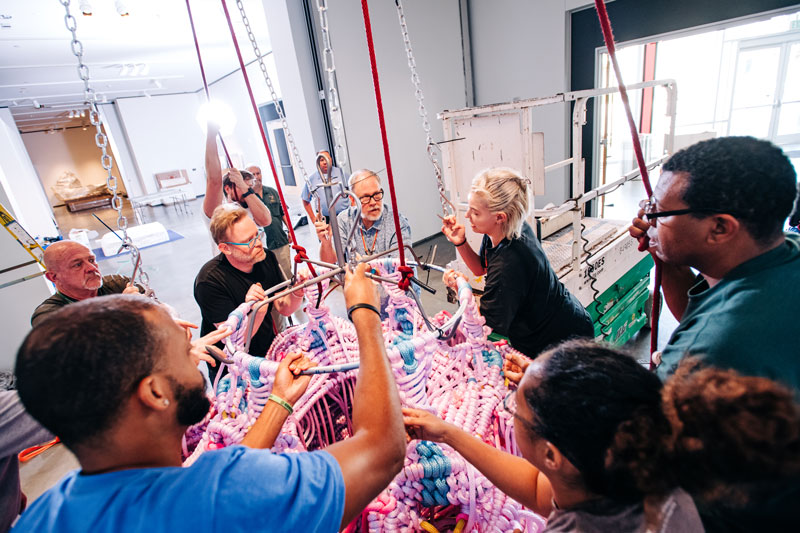 The AEIVA team plans far in advance, but also must remain flexible until the moment the show opens. For the Michael Dixon exhibition, conversation with the artist started five years in advance. With more than 40 paintings in his show, the staff had to remove three once they arrived because there were too many for the space.
The AEIVA team plans far in advance, but also must remain flexible until the moment the show opens. For the Michael Dixon exhibition, conversation with the artist started five years in advance. With more than 40 paintings in his show, the staff had to remove three once they arrived because there were too many for the space. Handling art includes restrictions in how it travels, via special shipping companies whose employees are trained in proper protocol for handling artwork. There will be a lot of physicality, brain work, and logistics.
Lily Reeves delivered her fragile neon works from New Mexico herself. AEIVA staff once drove nonstop from Philadelphia to Birmingham with a van full of sculptures, because once in their possession, insurance dictated they could not leave the art unattended.
Along with exhibition design and layout, installation is an art form itself, requiring experience and precision, says Fields, who was a student gallery assistant while earning his undergraduate degree at UAB, and still enjoys doing AEIVA’s lighting himself.
“We start out with a traditional approach, where everything is evenly spaced and formal, and then once you get it to that point, you can identify opportunities to creatively break those rules,” he said.
It is vital to ensure what they present is culturally accurate. Many of the exhibitions AEIVA presents deal with difficult subject matters. Cultural institutions are now realizing they cannot tell other people’s story without their involvement. By inviting experts to contribute, community curation helps everyone feel ownership over the exhibitions.
“When we write the text panels, we are trying to make someone think about the world in a way they maybe have not thought of before, while also respecting that the viewer’s interpretation will be informed by their personal life experiences,” Fields said.
Once the work is on the wall, the public programming kicks in and the conversation begins all over again.
“None of it means anything if no one sees it,” Fields said.
 It takes a team: food is cooked and plated on the tray service lines, then delivered to patients by runners with trolleys. Food preparation, including slicing vegetables for salads, helps the kitchen run efficiently.
It takes a team: food is cooked and plated on the tray service lines, then delivered to patients by runners with trolleys. Food preparation, including slicing vegetables for salads, helps the kitchen run efficiently.  Each of the four boilers can convert 80,000 pounds of water into usable steam per hour. The water comes from three sources: drinking water, lake water, and on-site well water. The steam pipe runs underground at depths of 3 to 20 feet. Powered by natural gas, the boiler sends steam through nearly four miles of pipe to 45 buildings across campus. Workers in the pipe fitter department take care of the steam distribution lines.
Each of the four boilers can convert 80,000 pounds of water into usable steam per hour. The water comes from three sources: drinking water, lake water, and on-site well water. The steam pipe runs underground at depths of 3 to 20 feet. Powered by natural gas, the boiler sends steam through nearly four miles of pipe to 45 buildings across campus. Workers in the pipe fitter department take care of the steam distribution lines. Boiler Operator Craig Stillwell takes live boiler parameter readings, which are manually done “hands-on” to keep everyone aware of the status of the boilers that are in operation. Water is heated to 435 degrees Fahrenheit steam and 140 pounds per square inch, which sends it through the pipes. By the time it reaches a building, it’s at about 350-375 degrees Fahrenheit. At least two operators from the team of 12 are always on the job to monitor the state-of-the-art system and listen for alarms. Half learned their trade in the military.
Boiler Operator Craig Stillwell takes live boiler parameter readings, which are manually done “hands-on” to keep everyone aware of the status of the boilers that are in operation. Water is heated to 435 degrees Fahrenheit steam and 140 pounds per square inch, which sends it through the pipes. By the time it reaches a building, it’s at about 350-375 degrees Fahrenheit. At least two operators from the team of 12 are always on the job to monitor the state-of-the-art system and listen for alarms. Half learned their trade in the military.  The work “Adoration Garden” by artist Jacqueline Surdell is the most physically demanding piece AEIVA has presented. The piece arrived from Chicago, and UAB Arts Alliance senior stage manager Seth Cain and staff volunteered to help install it. Made with nylon cord and steel spool for this exhibition, the piece is estimated to weigh more than 500 pounds.
The work “Adoration Garden” by artist Jacqueline Surdell is the most physically demanding piece AEIVA has presented. The piece arrived from Chicago, and UAB Arts Alliance senior stage manager Seth Cain and staff volunteered to help install it. Made with nylon cord and steel spool for this exhibition, the piece is estimated to weigh more than 500 pounds. The AEIVA team plans far in advance, but also must remain flexible until the moment the show opens. For the Michael Dixon exhibition, conversation with the artist started five years in advance. With more than 40 paintings in his show, the staff had to remove three once they arrived because there were too many for the space.
The AEIVA team plans far in advance, but also must remain flexible until the moment the show opens. For the Michael Dixon exhibition, conversation with the artist started five years in advance. With more than 40 paintings in his show, the staff had to remove three once they arrived because there were too many for the space. 